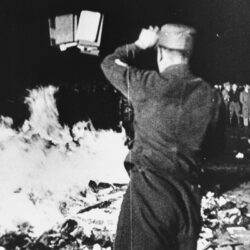A Short History of Contested Presidential Elections

The caption to this Thomas Nast cartoon from Harper’s Weekly in February 1877 reads, “A truce – not a compromise, but a chance for high-toned gentlemen to retire gracefully from their very civil declarations of war.”
On October 19 the Republican candidate for president told a national television audience of more than 65 million he would not confirm that he would accept the results of the election on November 8: “I’ll tell you at the time, I’ll keep you in suspense.” He has also maintained that this year’s presidential race is “rigged.” There have been a number of elections in American history where the results have been questionable and in one instance, 1860, where a section of the country left rather than assent to the electorate’s verdict. Yet, the peaceful transition of power and the losing candidate’s acceptance of the outcome has been one of the bedrocks of the American political system.
On two occasions, in 1800 and 1824, the House of Representatives has decided the winner. In the first the electoral system at the time produced a tie between Thomas Jefferson and Aaron Burr, even though both ran as the candidates of the Democratic-Republican party. Under the Constitution each state delegation casts one vote to resolve the contest. As expected, there was considerable maneuvering from the time of the electoral count on December 3 (at that point conducted in the state legislatures) to the convening of the House on February 11 (presidential inaugurations then took place on March 4). The opposition Federalists, whose candidate, incumbent John Adams, had lost, chose to back Burr. But their sitting secretary of the treasury, Alexander Hamilton, mistrusted Burr and argued for Jefferson. In the end a key abstention by Delaware’s lone member, James Bayard, finally broke a deadlock that lasted until the 36th ballot. Jefferson triumphed and Burr became his vice president. The whole mess led to the swift passage of the 12th Amendment to the Constitution, which had electors choosing the two top positions separately. (A full description of the maneuvering can be found in this 2004 article in Smithsonian magazine.)
In 1824, following the Era of Good Feeling during the presidency of James Monroe, there was a four-candidate contest for president. The candidates were Monroe’s Secretary of State John Quincy Adams (son of John); Monroe’s Treasury Secretary William H. Crawford; House Speaker Henry Clay; and Andrew Jackson, at the time a U.S. senator from Tennessee, but best known as a military leader in the War of 1812 and the Florida Indian Wars. Jackson would win 41 percent of the popular vote to Adams’ 31 percent, but in the Electoral College Jackson’s 99 votes fell 32 votes short of the required majority. Again the House of Representatives would determine the winner.
The 12th Amendment required the House to choose among the three top candidates: Jackson, Adams and Crawford (who had suffered a crippling stroke during the campaign). Henry Clay became the kingmaker. Although historians still debate whether there was a quid pro quo between Adams and Clay that led to the latter serving as Secretary of State, Jackson and his supporters certainly believed it. Although they acquiesced in Adams’ ascension to the White House, cries of “corrupt bargain” created legitimacy problems for Adam’s presidency. It also led Jackson and his followers to embark on the 1828 campaign immediately. As one history website has put it: “To Jacksonians the Adams-Clay alliance symbolized a corrupt system where elite insiders pursued their own interests without heeding the will of the people.” Sound familiar?
Another four-candidate contest occurred in 1860. Here the outcome was not in doubt as Republican Abraham Lincoln carried all the big-population Northern states, winning a clear majority in the Electoral College with a plurality — 40 percent — of the popular vote. The South, which had voted for John Breckenridge and John Bell, refused to accept the results and led by South Carolina on December 20, 1860, seceded from the Union. This led to the Civil War whose ramifications remained evident when the next crisis in presidential contests occurred in 1876.
In that Centennial year of the Republic, the contest between New York’s Democratic Governor Samuel Tilden and Ohio’s Republican Governor Rutherford Hayes became one of the most impugned in American history. Tilden clearly won the popular vote by over 250,000 votes; 51 percent to 48 percent. Tilden also led in the Electoral College 184-166 with three Southern states, South Carolina, Louisiana and Florida in dispute. Under reconstruction and with the presence of federal troops, Republicans had generally controlled these states’ governments. However, in 1876 intimidation of black voters and a growing disgust with “carpetbag” governments helped the Democrats, particularly in South Carolina where they succeeded in electing their candidate as governor. As a result, each of these three states sent two sets of elector returns to Congress.
To resolve the situation, Congress hastily enacted a law that provided for a 15-member Electoral Commission made up of five House members, five senators, and five Supreme Court justices. Some observers argued that the replacement of Justice Donald Davis whose appointment as a senator from Illinois forced his resignation from the court, by Joseph Bradley, swung the commission in the Republicans’ favor. The commission, in three 8-7 vote,s gave Hayes all the disputed votes so that the electoral vote was now 185-184 in his favor.
When the electoral count began in the Senate on February 1 trepidation existed that Democrats would raise objections or begin a filibuster. At the same time, the Hayes’ forces were negotiating with officials in the three states to bring their electoral votes into the Ohioan’s column. The crux of the deal was that federal troop would be withdrawn from the South in exchange for making Hayes president.
While all this was going on fears arose that things could turn violent. President Ulysses Grant ordered General William Tecumseh Sherman to bring federal troops to protect the Capitol from disgruntled Democrats. The man-of-war Wyoming was stationed in the Potomac to protect the bridges over the Anacostia River and a contingent of Marines guarded Chain Bridge between Virginia and the District.
Even as late as the day before the March 4 inauguration, there was still activity, such as Southern Democrats blocking the defense appropriations bill in the House to make sure the troops would indeed withdraw. A House resolution passed condemning the commission and declaring Tilden “the duly elected President of the United States.” The resolution had no impact.
So Hayes became president. Tilden accepted the result, remarking: “I can retire to public life with the consciousness that I shall receive from posterity the credit of having been elected to the highest position in the gift of the people, without any of the cares and responsibilities of the office.” Historians credit Tilden for preventing what could have been a dangerous situation. (For a vivid description of the shenanigans surrounding the 1876 election and its context, see The Year of the Century: 1876 by Dee Brown.)
In the extremely close election of 1960, in which Kennedy beat Nixon by less than 0.2 percent in the popular vote, the Electoral College exaggerated the margin 303-219 for Kennedy. There were claims of voter fraud in Illinois and Texas. Kennedy won Illinois by less than 9,000 votes and Texas by over 46,000. No fraud was proven and whatever Mayor Richard J. Daley did for JFK in Chicago may have been matched by downstate Republicans for Nixon. In his memoirs, Nixon suggests he was tempted by calls for a recount, but indicated it could take six months and “the effect could be devastating to America’s foreign relations. I could not subject the country to such a situation.”
Our contemporary example of a major disputed election occurred in 2000. Here Democrat Al Gore won the popular vote by more than 543,000 votes: 48.4 percent to 47.9 percent. However, Gore could not secure the required majority of Electoral College votes, getting stuck on 267 votes, four short of a majority. Those of us who stayed up all that election night, watched the networks produce what CBS analyst Jeff Greenfield later called “One Order of Crow” and the late Tim Russert drawing on his mini-white board, “Florida, Florida, Florida.” While the dispute went on through November and into early December, we learned about hanging chads, caused by a ballot design that asked voters to push a stylus through a board to signify their vote choice . As a result of this, there were many post-election conference panels on ballot design. We also experienced again the power of third-party candidates, in this case Ralph Nader, to influence an election outcome. We also now know that current Trump campaign adviser Roger Stone organized mobs to protest and create chaos outside the building where the initial Florida recounts took place.
The dispute over Florida’s 25 electoral votes went all the way to the Supreme Court. The court issued its opinion late on December 12, ruling that there was an Equal Protection Clause violation in using different standards of counting in different counties. They also determined that no alternative method could be established within the time limit set by the United States Code’s section regarding the “determination of controversy as to appointment of electors,” which was December 12. Thus, Bush’s slim margin of victory in Florida, in the end 930 votes including absentees, stood.
During Bush’s 2004 re-election campaign against then Massachusetts Senator John Kerry some raised the specter of voting machine hacking, especially since the Diebold Company, which made many of these machines, had ties to the Republican Party. After 2004 there were many conference panels on protection of the vote count and how to secure voting machines. Current fears related to this issue has arisen in the wake of hacking of the Clinton campaign and the Democratic National Committee.
After the Supreme Court decision in 2000, Gore conceded the following day. In his speech he quoted Stephen A. Douglas, one of the losers of the 1860 election who told Abraham Lincoln: “Partisan feeling must yield to patriotism. I’m with you, Mr. President, and God bless you.” Gore added, “I say to President-elect Bush that what remains of partisan rancor must now be put aside, and may God bless his stewardship of this country. Neither he nor I anticipated this long and difficult road. Certainly neither of us wanted it to happen. Yet it came, and now it has ended, resolved, as it must be resolved, through the honored institutions of our democracy.”
Will Donald Trump, should he lose, and the polls at the moment suggest that is likely, stick with his defiant “rigged election” claim and encourage his supporters to reject the legitimacy of a Hillary Clinton presidency? Or will he protect the integrity of America’s political process and institutions and preserve the tradition of presidential election losers and accept the transfer of power and the elevation of his vanquisher to the highest office in the land? Stay tuned!

























































































